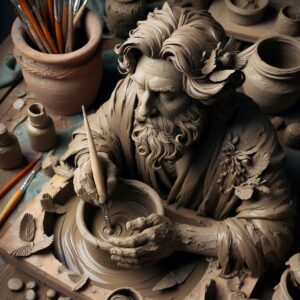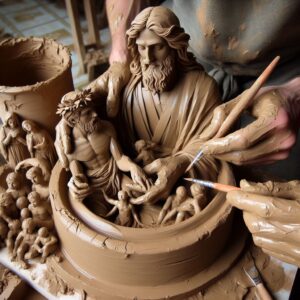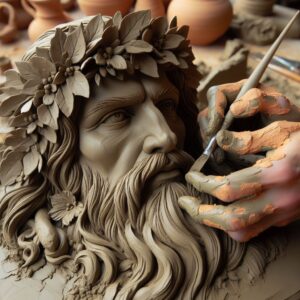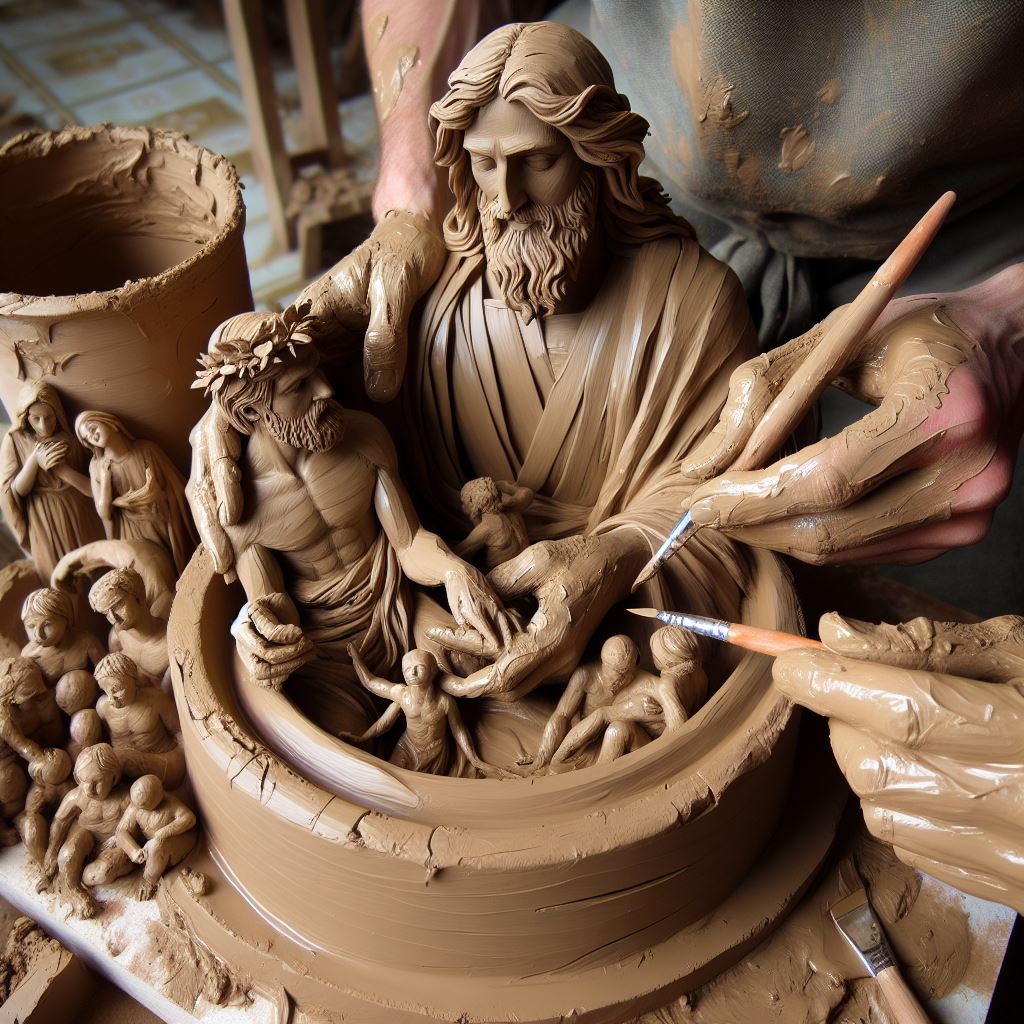Table Of Contents
- 1 Unveiling the Secrets of Oil-Based Clay Sculpting
- 1.1 Delving into the Essence of Oil-Based Clay:
- 1.2 Unveiling the Tools of the Trade:
- 1.3 Exploring the World of Oil-Based Clay:
- 1.4 Demystifying the Techniques of Oil-Based Clay Sculpting
- 1.5 Preparing Your Clay:
- 1.6 Shaping and Sculpting:
- 1.7 Additional Techniques:
- 1.8 Tips and Tricks:
- 1.9 Polishing Your Skills and Unveiling the Magic of Mold-Making
- 1.10 Finishing Your Sculpture:
- 1.11 Unveiling the Magic of Mold-Making:
- 1.12 Exploring Creative Possibilities:
- 1.13 Sculpting Conclusions and FAQs for Oil-Based Clay Artists
- 1.14 Key Takeaways:
- 1.15 Frequently Asked Questions:
Unveiling the Secrets of Oil-Based Clay Sculpting

For the passionate sculptor seeking a versatile and forgiving medium, oil-based clay offers a captivating world of creative possibilities. Unlike its water-based counterparts, oil-based clay holds its shape readily, allowing for meticulous detail and intricate designs. But with this unique material comes a specific set of techniques and considerations, crucial for unlocking its full potential.
Delving into the Essence of Oil-Based Clay:
Oil-based clay, often referred to as plasticine, is a non-drying sculpting medium composed primarily of waxes and oils. This composition grants it several key advantages:
- Durability: Unlike water-based clays, which can crack and crumble when dry, oil-based clay remains pliable for extended periods, allowing for revisions and adjustments throughout the creative process.
- Reusability: Sculptures crafted from oil-based clay can be softened and reshaped again and again, minimizing waste and encouraging experimentation.
- Fine Detailing: The smooth and consistent texture of oil-based clay makes it ideal for creating intricate details and delicate features, adding depth and dimension to your sculptures.
- Non-Toxic: Oil-based clays are generally non-toxic and safe for artists of all ages, making them a suitable choice for educational and family-oriented projects.
Unveiling the Tools of the Trade:
While oil-based clay is inherently forgiving, a few essential tools will enhance your sculpting experience and elevate your creations. Here are some key items to consider:
- Sculpting Tools: Invest in a set of sculpting tools, including spatulas, knives, and loop tools for shaping, cutting, and adding details.
- Rolling Pin: A rolling pin helps roll out the clay evenly, creating flat sheets for intricate designs and adding texture.
- Texturing Tools: Experiment with various textured rollers, combs, and stamps to add visual interest and depth to your sculptures.
- Heat Source: A heat box, microwave, or heat lamp plays a crucial role in softening oil-based clay, making it more malleable and easier to work with.
Remember: Use a heat source, like a heat box, microwave, or heat lamp, to warm your clay as you are sculpting. This will make it more pliable and easier to work with.
Exploring the World of Oil-Based Clay:
With your tools and clay ready, prepare to embark on a captivating creative journey. Here are some key techniques to master:
- Pinching and Coiling: These fundamental techniques involve manipulating the clay with your fingers to create basic shapes and forms, laying the groundwork for more complex designs.
- Slab Construction: Roll out the clay into flat sheets and assemble them to build sculptures, offering endless possibilities for creating structures, figures, and decorative objects.
- Carving and Sculpting: Once the basic shape is formed, utilize your tools to refine the details, carve out specific features, and add your unique artistic touch.
- Texturing: Experiment with different tools and techniques to add texture to your sculptures, enhancing their visual appeal and storytelling potential.
In next we will delve deeper into the practical application of these techniques, offering valuable tips and tricks to guide you on your journey of oil-based clay sculpting.
Demystifying the Techniques of Oil-Based Clay Sculpting

Now that you’ve grasped the essence of oil-based clay and assembled your tools, let’s delve into the practical application of various sculpting techniques.
Preparing Your Clay:
- Heating: As mentioned earlier, remember to warm your oil-based clay before sculpting. This can be achieved using a heat box, microwave, or heat lamp. Apply heat evenly and avoid overheating, which can cause the clay to become too soft and sticky.
- Kneading: Thoroughly knead the softened clay to remove any air pockets and ensure consistency throughout. This promotes smooth sculpting and prevents cracks or air bubbles in your final piece.
Shaping and Sculpting:
- Pinch and Coil: Start with basic shapes like spheres, cones, and cylinders by pinching the clay between your fingers. Use the coiling technique to join these shapes and build more complex forms.
- Slab Construction: Roll out the clay evenly using a rolling pin to create flat sheets. Cut the sheets into desired shapes and assemble them using slip (a thin paste made from clay and water) to build your sculpture.
- Carving and Sculpting: Refine your work by carving and sculpting with your tools. Knives and spatulas are great for shaping larger areas, while loop tools help create finer details and textures.
- Texturing: Experiment with various textured rollers, combs, and stamps to add visual interest and depth to your sculptures. Press the textured tools gently into the clay to create unique patterns and surfaces.
- Blending and Smoothing: Use your fingers or tools to blend seams and smooth out any rough edges for a cleaner and more polished final look.
Additional Techniques:
- Armatures: For larger or more intricate sculptures, consider using an armature, a wire frame that provides support and structure. This helps prevent the clay from slumping or collapsing while drying.
- Adding color: While oil-based clay itself comes in limited colors, you can add vibrant hues and accents using acrylic paints, oil paints, or colored powders.
Tips and Tricks:
- Work in small sections: Instead of trying to sculpt the entire piece at once, focus on smaller areas at a time. This allows for greater control and precision.
- Keep your tools clean: Wipe your tools regularly to prevent the clay from drying on them and affecting your sculpting.
- Store unused clay properly: Wrap unused clay in plastic wrap or store it in an airtight container to prevent it from drying out.
- Practice and experiment: Don’t be afraid to experiment and have fun with different techniques. The more you practice, the more comfortable and skilled you will become.
By mastering these techniques and exploring your creative vision, you can unlock the boundless possibilities of oil-based clay sculpting. Get ready for the next, where we’ll explore the finishing touches and delve into the fascinating world of mold-making and casting.
Polishing Your Skills and Unveiling the Magic of Mold-Making

As your oil-based clay sculpture takes shape, it’s time to focus on polishing your skills and exploring exciting finishing touches. Let’s delve into the world of mold-making and casting, unlocking new creative possibilities with your sculpted masterpieces.
Finishing Your Sculpture:
- Drying: Once you are satisfied with your sculpture, allow it to dry completely. This can take several days depending on the size and thickness of the sculpture.
- Sanding: Once dry, use fine-grit sandpaper to smooth out any rough edges or imperfections. Be gentle and work in small sections to avoid damaging the details.
- Sealing: Although oil-based clay is relatively durable, applying a sealant can further protect your sculpture from dust, moisture, and fading. Choose a sealant specifically formulated for oil-based clays and follow the manufacturer’s instructions carefully.
Unveiling the Magic of Mold-Making:
Mold-making allows you to create multiple copies of your original sculpture, multiplying your creative output and sharing your artwork with others. Here’s a glimpse into the process:
1. Choosing a Mold Material:
- Silicone Rubber: This versatile material offers excellent detail capture and flexibility, making it ideal for complex sculptures.
- Alginate: This affordable material is easy to use but may not capture fine details as well as silicone rubber.
- Plaster: Traditional plaster molds are strong and durable but require more preparation and expertise.
2. Creating the Mold:
- Prepare the sculpture: Apply a release agent to your sculpture to prevent the mold material from sticking.
- Build a mold box: Construct a box around your sculpture to contain the mold material.
- Mix and pour the mold material: Follow the manufacturer’s instructions for mixing and pouring the chosen mold material.
- Cure the mold: Allow the mold material to cure completely before removing it from your sculpture.
3. Casting Your Sculpture:
- Choose a casting material: Options include resin, wax, or even concrete, each offering unique properties and finishes.
- Prepare the mold: Apply a release agent to the mold cavity.
- Mix and pour the casting material: Follow the instructions for your chosen casting material.
- Demold and finish: Once the casting material has cured, remove it from the mold and finish as desired.
Exploring Creative Possibilities:
Mold-making opens a door to a world of creative possibilities. You can experiment with different casting materials, colors, and finishes to create unique variations of your original sculpture. Additionally, you can use your molds to create decorative elements like jewelry, tiles, or wall hangings.
Remember, mold-making requires some practice and patience. With dedication and the right resources, you can master this exciting technique and elevate your oil-based clay sculpting journey to new heights.
Next, we’ll solidify your understanding with key takeaways and address frequently asked questions to empower you to confidently navigate the world of oil-based clay sculpting.
Sculpting Conclusions and FAQs for Oil-Based Clay Artists
As we conclude our exploration of oil-based clay sculpting, let’s solidify your understanding with key takeaways and address frequently asked questions to empower you to confidently embark on this rewarding creative journey.
Key Takeaways:
- Oil-based clay offers a versatile, forgiving, and durable sculpting medium ideal for beginners and experienced artists alike.
- Basic techniques like pinching, coiling, slab construction, carving, and texturing are fundamental to shaping and refining your sculptures.
- Heating the clay before sculpting improves its malleability and allows for smoother working and intricate details.
- Finishing touches like sanding, sealing, and mold-making enhance the durability and presentation of your sculptures, unlocking further creative possibilities.
Frequently Asked Questions:
1. What types of oil-based clay are available?
Various brands and types of oil-based clay exist, each with slightly different properties. Some popular choices include Chavant, Monster Clay, and Sculpey Super Sculpey. Consider factors like firmness, color options, and price when making your selection.
2. How long does oil-based clay last?
When stored properly in an airtight container, oil-based clay can last for years without drying out. This allows you to revisit your sculptures and make adjustments as needed over time.
3. Can I use oil paints on oil-based clay sculptures?
Yes, oil paints are a popular choice for adding color and details to oil-based clay sculptures. However, ensure the clay is completely dry before applying paints to prevent smudging and discoloration.
4. How do I clean oil-based clay from my tools?
Wipe your tools clean with a damp cloth or paper towel while the clay is still soft. For stubborn residue, use mineral spirits or a solvent specifically designed for oil-based clays.
5. Where can I learn more about oil-based clay sculpting?
Several online resources, tutorials, and books offer valuable insights and guidance on oil-based clay sculpting techniques. Additionally, consider attending workshops or joining online communities to connect with other artists and share your experiences.
Embrace the creative potential of oil-based clay sculpting. With dedication, practice, and the knowledge gained from this exploration, you can sculpt your artistic vision and embark on a rewarding journey of self-expression and creativity.
